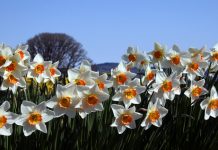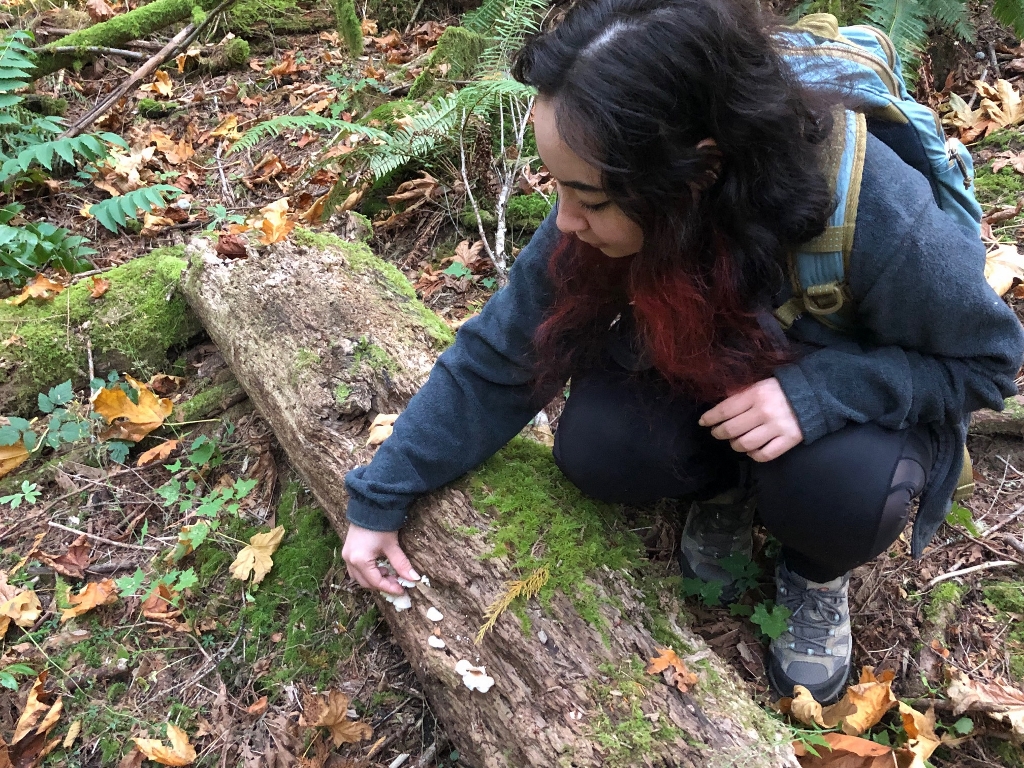Agroup of mushrooms is called a “cluster” if the fungi are extremely close together, or a “troop” if they are lined up like little soldiers. Wild Mushroom picking in Olympia on the The Evergreen State College’s (Evergreen) forest trails provides all the clusters, troops, and lone fungus your heart could desire.
“Evergreen is great, as it’s an open campus and anyone can come in,” says Marie Kelley, a member of the South Sound Mushroom Club (SSMC) during a recent mushroom hunting visit to the college’s lovely Beach Trail. “Keep your eyes peeled,” she says. She notes that while you can find mushrooms along the trails, more are located just off the path.
“Make sure you bring a friend, and let people know you are out,” she adds as tips to keep you safe while foraging.
Evergreen has lots to offer for mushroom picking in its campus forest, so it’s a treat to hunt there.
Diverse Species for Wild Mushroom Hunting at The Evergreen State College
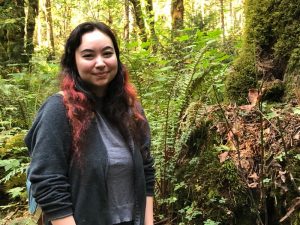
The iNaturalist posts descriptions, photos and a map of more than 2,000 documented observations of 430 fungi and lichen species at Evergreen in just the last couple of years. The iNaturalist is a joint initiative of the California Academy of Sciences and the National Geographic Society, helping identify plants and animals and reporting on nature projects and data.
Coniferous and temperate forests like those that envelop Evergreen are perfect homes for delectable wild fungi. That’s why mushroom foragers can hunt for peppery chanterelles, potassium rich mica caps, savory oyster mushrooms, aromatic matsutake “pine mushrooms,” colorful parrot waxcaps and many more during their forays into the woods. Some edible mushrooms are harvested as an ingredient to add to delicious meals. Others are not edible and are sought simply for the love of the hunt, for scientific reasons, or just to observe the area’s diverse biology.
Kelley, who obtained a Bachelor of Science degree at Evergreen and studied mushrooms there, says she has spotted a variety of species in the college’s forests. “I look for anything I can find,” she explains. “In late spring, it’s oyster mushrooms. In the fall, I look for chanterelles.”
Chanterelle Mushroom Hunting in Olympia
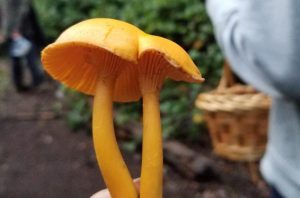
As Kelly says, autumn means it’s an especially good time to be on the lookout for the well-known chanterelles. A particular favorite is the Pacific golden chanterelle (Cantharellus formosus) because of its peppery flavor and fruity aroma.
Evergreen professor and author Paul Przybylowicz researches and teaches on soil fungi, mushroom cultivation and potential uses for fungi. He says the woods surrounding the college provide two factors ideal for chanterelles. “First is the age of the forest, which is about 70 years,” he says. “Chanterelles are not found in abundance in really young or really old stands.” He explains that these wild mushrooms have a mycorrhizal relationship with trees in a middle-aged forest, meaning in a symbiotic way the fungi feed on sugars from the tree and the fir provides nutrients for the mushrooms.
Przybylowicz says the second factor in locating chanterelles is “random chance” such as whether the stand has the right combination of vegetation, including Douglas firs, hemlocks and huckleberry, all of which are part of Evergreen’s forest. “All these say, ‘good chanterelle picking,’” he says.
Resources for Mushroom Foraging in Olympia
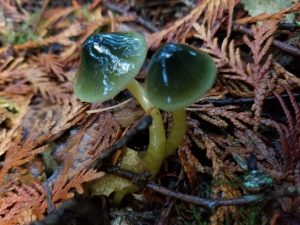
Knowing which mushrooms are edible is critical because some are deadly. Experienced mushroom hunters say do not eat a mushroom that you cannot positively identify, that is over-ripe, damaged, collected from contaminated areas, or for which you have any question.
When in doubt, consult an expert! And luckily, there are a lot of local resources to help you forage at Evergreen and other Thurston County sites. For example, consider joining the South Sound Mushroom Club, which provides mushroom hunts during mushroom seasons, weekend getaways and participation in local mushroom-related events. The club also offers online articles and a lending library.
Many other online resources are available, such as this field guide. Several helpful books can be purchased or may be available at the library.
The Evergreen State College is a Center for Mushroom Knowledge
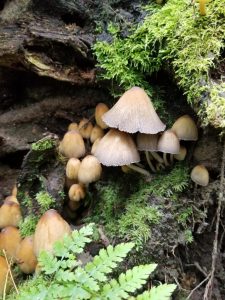
The college itself is known as a center of fungi study, producing expert professors and well-known authors. Those include “celebrity mushroom scientist” (mycologist) Paul Stamets, legendary Michael Beug who taught chemistry, mycology and organic farming at Evergreen for 32 years, as well as Przybylowicz. Przybylowicz often teaches a class called “The Fungal Kingdom,” as one of his many courses over his last three decades of instruction. “We are the only place in the country, and maybe in the world, where you can take mycology intensive courses as an undergraduate,” he says.
The Evergreen State College’s Olympia location in the mushroom-abundant Pacific Northwest, plus the school’s deep well of fungi knowledge, means that if you are either the casual mushroom forager walking along Evergreen’s trails or someone interested in the serious study of fungi, you are looking in the right spot at Evergreen.
Sponsored





